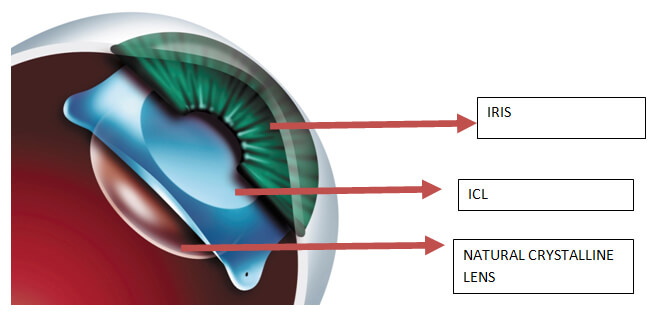ICL Implantation for A Lifetime of Clear Vision
Near Sightedness | Farsightedness | Astigmatism
What is ICL implantation?
ICL implantation requires surgery that involves a surgeon placing a Collamer lens or artificial lens made of plastic and collagen, between your natural human lens and the iris. ICL is a new form of “additive” technology where a specially designed lens is made for you and inserted in front of the human lens but behind the iris. This gives excellent vision without reshaping the cornea and is ideal for most patients.” This contrasts to “destructive technology” such as laser eye surgery, which uses a laser to remove small amounts of corneal tissue to reshape it to better focus light. When used effectively, it can eliminate the need for glasses or contact lenses by focusing the light sharply onto the retina.

Benefits / Risk for ICL Implantation
Benefits of ICL
In addition to improved vision, there are numerous benefits of ICL implantation, which includes:
- Sharper, Clearer Vision.
- Correct high degrees of Myopia (-3.00 to -20.00 D).
- Unlike RLE, ICL implantation keeps the eye’s natural lens intact, maintaining focusing ability.
- Ideal for people with thin corneas or dry eyes.
- It can be updated if vision changes over time.
- The collamer material provides built-in UV protection, protecting eyes from UV exposure.
- No risk of lens-related infections from improper contact lenses.
- Recovery is quick because tissue isn’t removed.
- The lens provides great night vision.
- Perfect for candidates who cannot get LASIK.
Risks of ICL
Though ICL is mostly a safe surgery, certain complications can arise, including:
- It may block natural fluid drainage from the eye, leading to increased risk of intraocular pressure and potential glaucoma.
- It may cause early cataract formation.
- There is a risk of retinal detachment.
- There is a small risk of infection (endophthalmitis) or inflammation.
- Vision loss can also occur due to high pressure in the eye.
- In severe cases of complication, the ICL lens could be displaced and require surgical adjustment.
- Some patients may experience glare, halo, or starbursts around lights at night.
- To prevent pressure buildup, some patients may also require a small hole before surgery.
Recovery And Outlook
After ICL Surgery, the patient can experience mild discomfort, light sensitivity, and blurry vision in the first 24-48 hours. Hence, patients are recommended to avoid rubbing eyes and use prescription eye drops to help prevent infection and swelling. Later on, in the first week, the vision stabilises and the patient might experience mild halos or glare. During the first week, the patients are advised to avoid heavy lifting that can put strain on the eyes and wear protective glasses when outdoors.
After a month, most patients experience full vision improvement. However, one must go for regular check-ups to ensure proper healing and eye pressure stability.
Long Term Outlook
- High Success Rate – Over 95% of patients achieve significantly improved vision.
- Stable Results – The ICL is designed to last a lifetime with no maintenance.
- Reversible Option – If necessary, the lens can be removed or replaced.
- Minimal Risk of Dry Eye – Unlike LASIK, ICL does not thin the cornea.
Ideal Candidates for ICL
For many people, ICL is preferable to laser eye surgery when correcting their short-sightedness, long sightedness and/or astigmatism. Strong levels of evidence shows that ICL has the same final vision as laser eye surgery; in other words it is no worse than laser eye surgery. However, ICL is superior to laser eye surgery in terms of quality of vision. This is because there is no treatment to the cornea that may induce aberrations. Thus, colour saturation, contrast sensitivity and vision in poor lighting is often better with ICLs than that achieved through laser vision correction. Further, ICL is ideal in patients whose corneas are too thin for laser eye surgery, or who has dry eye symptoms that prevent laser eye surgery.
The checklist for ICL includes:
- Aged between 21 to 45 years.
- A stable prescription with no change in their glass’s prescription beyond 0.5D over the past year.
- Anyone with nearsighted vision with mild to severe myopia (-2D to -20D)
- The person should have a good endothelial cell density (measured in clinic) and an adequate anterior chamber depth for safe implantation.
- Anyone looking to avoid dry eye syndrome.
Estimated Cost Involved
Comparatively, ICL is a bit more expensive than LASIK, but all for the right reasons. It is more intensive, long-lasting, and more reliable. The cost for ICL can vary depending on the type/power of ICL needed for your eye and ranges from $3000-$5000 per eye. Also, since this is an elective procedure, it is very likely that your insurance company won’t cover this expense. However, we offer a number of monthly payment plans to make your vision dreams more clearer.
FAQ's
Typically, ICLs for both eyes are done under general anaesthetic. This means you are asleep for the procedure and will not feel a thing. Occasionally, the operation is undertaken under local anaesthetic and in that case the eyes are made numb so there is no discomfort.
The lens involved in ICL is made of biocompatible tissues. This means it can stay and support your eye lifelong unless your vision changes.
ICL is minimally invasive. In most cases, the eye shall heal and regain normal functionality within 24-48 hours of treatment.
Although of low percentage (generally less than 1%), a few risks associated with ICL implantation include blurred vision, early cataracts, cloudy corneas, glaucoma, retinal detachment, and vision loss.
The lens involved in ICL is made of biocompatible tissues. This means it can stay and support your eye lifelong unless your vision changes.
ICL uses “additive technology” to implant a Collamer lens into the eye without removing the natural lens. This biocompatible lens is stable, soft, foldable, moist, and small. Due to its small size, only a microscopic incision (keyhole surgery) is made that requires no stitches, hence retaining the natural shape and health of the cornea. It can indefinitely remain inside the eye without damaging the corneal curvature or tissue.
LASIK surgery involves reshaping the cornea with a laser. ICL is usually recommended as a replacement technique for people whose cornea aren’t thick enough to be treated safely with LASIK or laser surgery, or in those who have significant dry eye symptoms.
In some cases, as a person ages, the chances of developing cataract increases. This is the most common reason to get the ICL lens removed. Another rare yet possible reason is increased intraocular pressure in the eyes. It is removed through keyhole surgery and in most cases there are no issues or side effects from surgery.
- Let your doctor know about all the medications you are taking. He may ask you to stop taking them three-four days before your scheduled surgery date.
- If you wear rigid gas-permeable contact lenses, your doctor may ask you to stop wearing them a week prior to the surgery. Other types of lenses should also be avoided immediately before the procedure.
- Immediately after the surgery, you won’t be able to drive. It’s a good idea to have someone pick you up from the hospital.
Yes, and often to excellent outcomes.
